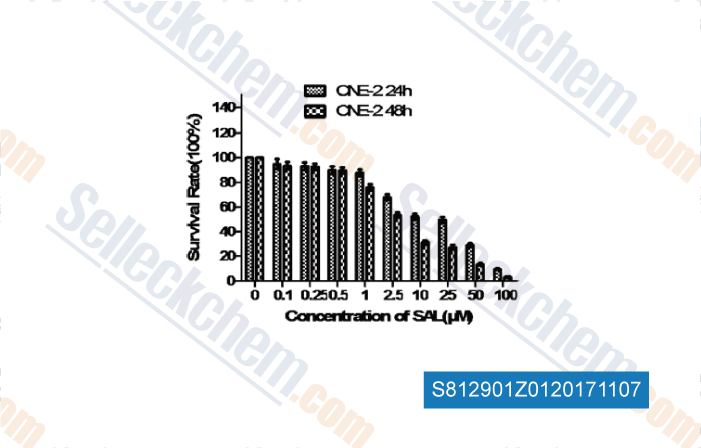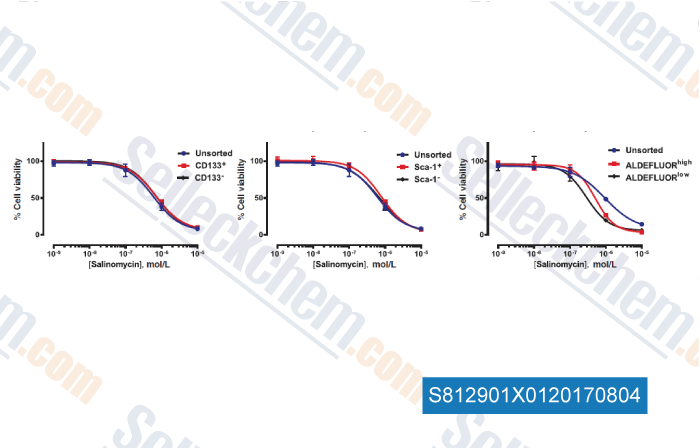|
Toll Free: (877) 796-6397 -- USA and Canada only -- |
Fax: +1-832-582-8590 Orders: +1-832-582-8158 |
Tech Support: +1-832-582-8158 Ext:3 Please provide your Order Number in the email. |
Technical Data
| Formula | C42H70O11 |
||||||
| Molecular Weight | 751.00 | CAS No. | 53003-10-4 | ||||
| Solubility (25°C)* | In vitro | DMSO | 100 mg/mL (133.15 mM) | ||||
| Ethanol | 15 mg/mL (19.97 mM) | ||||||
| Water | Insoluble | ||||||
| In vivo (Add solvents to the product individually and in order) |
|
||||||
|
* <1 mg/ml means slightly soluble or insoluble. * Please note that Selleck tests the solubility of all compounds in-house, and the actual solubility may differ slightly from published values. This is normal and is due to slight batch-to-batch variations. * Room temperature shipping (Stability testing shows this product can be shipped without any cooling measures.) |
|||||||
Preparing Stock Solutions
Biological Activity
| Description | Salinomycin, traditionally used as an anti-coccidial drug, has recently been shown to possess anti-cancer and anti-cancer stem cell (CSC) effects. | |
|---|---|---|
| Targets |
|
|
| In vitro | Salinomycin, a polyether ionophore antibiotic isolated from Streptomyces albus, has been shown to kill CSCs in different types of human cancers, most likely by interfering with ABC(ATP-binding cassette) drug transporters, the Wnt/β-catenin signaling pathway, and other CSC pathways. Salinomycin exhibits antimicrobial activity against Gram-positive bacteria including Bacillus subtilis, Staphylococcus aureus, Micrococcus flavus, Sarcina lutea, Mycobacterium spp., some filamentous fungi, Plasmodium falciparum, and Eimeria spp., protozoan parasites responsible for the poultry disease coccidiosis. In addition, salinomycin has early been shown to act in different biological membranes, including cytoplasmic and mitochondrial membranes, as a monovalent cation ionophore with strict selectivity for alkali ions and a strong preference for K+, thereby promoting mitochondrial and cytoplasmic K+ efflux and inhibiting oxidative phosphorylation. Salinomycin can induce massive apoptosis in human cancer cells of different origin that display multiple mechanisms of drug and apoptosis resistance[1]. | |
| In vivo | Salinomycin is able to effectively eliminate CSCs and to induce partial clinical regression of heavily pretreated and therapy-resistant cancers. It has also been demonstrated as a positive ionotropic and chronotropic agent that increased cardiac output, left ventricular systolic pressure, heart rate, mean arterial pressure, coronary artery vasodilatation and blood flow, and plasma catecholamine concentration. These results have been obtained in experiments with mongrel dogs that has received a single intravenous injection of 150 μg/kg salinomycin. However, It has been reported with a considerable toxicity of salinomycin in mammals, such as horses, pigs, cats, and alpacas after accidental oral or inhalative intake. Risk assessment data recently published by the European Food Safety Authority declare an acceptable daily intake (ADI) of 5 μg/kg salinomycin for humans, because daily intake of more than 500 μg/kg salinomycin by dogs leads to neurotoxic effects, such as myelin loss and axonal degeneration. Intravenous administration of 200-250 μg/kg salinomycin every second day for three weeks results in partial regression of tumor metastasis and shows only minor acute and long-term side effects, but no severe acute and long-term side effects observed with conventional chemotherapeutic drugs[1]. |
Protocol (from reference)
| Cell Assay: |
|
|---|---|
| Animal Study: |
|
References
|
Customer Product Validation

-
Data from [Data independently produced by , , Tumour Biol, 2016, 305-11]

-
Data from [Data independently produced by , , Tumor and Stem Cell Biology, 2015, 75(21):4582-4592.]
Selleck's Salinomycin (from Streptomyces albus) has been cited by 21 publications
| MUC1-C is a target of salinomycin in inducing ferroptosis of cancer stem cells [ Cell Death Discov, 2024, 10(1):9] | PubMed: 38182558 |
| Using a Quantitative High-Throughput Screening Platform to Identify Molecular Targets and Compounds as Repurposing Candidates for Endometriosis [ Biomolecules, 2023, 13(6)965] | PubMed: 37371546 |
| Inhibiting BRAF/EGFR/MEK suppresses cancer stemness and drug resistance of primary colorectal cancer cells [ Oncotarget, 2023, 14:879-889] | PubMed: 37791907 |
| Inhibiting BRAF/EGFR/MEK suppresses cancer stemness and drug resistance of primary colorectal cancer cells [ Oncotarget, 2023, 10.18632/oncotarget.28517] | PubMed: 37791907 |
| WNT Co-Receptor LRP6 Is Critical for Zygotic Genome Activation and Embryonic Developmental Potential by Interacting with Oviductal Paracrine Ligand WNT2 [ Genes (Basel), 2023, 14(4)891] | PubMed: 37107647 |
| Curcumin Analog, HO-3867, Induces Both Apoptosis and Ferroptosis via Multiple Mechanisms in NSCLC Cells with Wild-Type p53 [ Evid Based Complement Alternat Med, 2023, 2023:8378581] | PubMed: 36814470 |
| Salinomycin-Loaded High-Density Lipoprotein Exerts Promising Anti-Ovarian Cancer Effects by Inhibiting Epithelial-Mesenchymal Transition [ Int J Nanomedicine, 2022, 17:4059-4071] | PubMed: 36105618 |
| Avasimibe Alleviates Disruption of the Airway Epithelial Barrier by Suppressing the Wnt/β-Catenin Signaling Pathway [ Front Pharmacol, 2022, 13:795934] | PubMed: 35222024 |
| In Vitro Antiviral Activities of Salinomycin on Porcine Epidemic Diarrhea Virus [ Viruses, 2021, 13(4)580] | PubMed: 33808275 |
| Inhibition of Wnt/β-catenin Pathway Reverses Multi-Drug Resistance and EMT in Oct4 +/Nanog + NSCLC Cells [ Biomed Pharmacother, 2020, 16;127:110225] | PubMed: 32428834 |
RETURN POLICY
Selleck Chemical’s Unconditional Return Policy ensures a smooth online shopping experience for our customers. If you are in any way unsatisfied with your purchase, you may return any item(s) within 7 days of receiving it. In the event of product quality issues, either protocol related or product related problems, you may return any item(s) within 365 days from the original purchase date. Please follow the instructions below when returning products.
SHIPPING AND STORAGE
Selleck products are transported at room temperature. If you receive the product at room temperature, please rest assured, the Selleck Quality Inspection Department has conducted experiments to verify that the normal temperature placement of one month will not affect the biological activity of powder products. After collecting, please store the product according to the requirements described in the datasheet. Most Selleck products are stable under the recommended conditions.
NOT FOR HUMAN, VETERINARY DIAGNOSTIC OR THERAPEUTIC USE.
